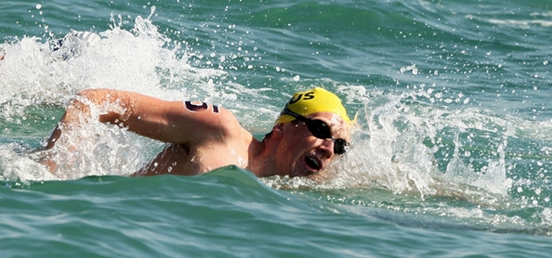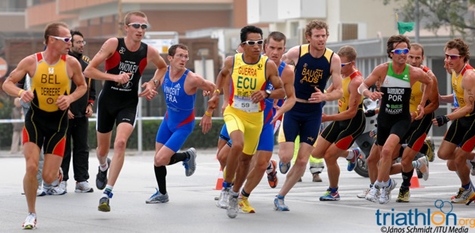Hydration for Endurance Athletes like Distance Runners, Swimmers, Cyclists and Ironman Triathletes
The purpose of this article is to (i) educate you on the physiologic role hydration plays in endurance athletic performance and injury prevention, (iii) have you learn the warning signs of dehydration, (iv) teach the importance of maintaining electrolyte balance when considering hydration, (v) recommend specific hydration quantity, (vi) suggest the benefits of nonfat milk as a healthy hydration source and (vii) help you be a better athlete!!
What is the Function of Hydration?
Our body composition is 66% water. Fluid and electrolyte balance is a major function of homeostasis, which is our body's ability to maintain its internal environment as it adjusts to challenges and stress. To the extent our bodies are able to adjust to these challenges the state of good health is maintained. Proper hydration is important for cellular metabolism, blood flow and therefore athletic performance.
Warning Signs of Dehydration
If your are feeling thirsty, you are already somewhat dehydrated. The warning signs of dehydration include:
- Thirst
- Muscle cramping
- Headaches
- Dry mouth
- Weakness
- Unclear thinking
- Fatigue
- Bloating
- Dark yellow urine
- Significant weight loss during exercise
- Decrease of sweat during exercise
Fluid Intake Requirements for Distance Runners, Cyclists, Hikers, Swimmers and Ironman Triathletes
The best hydration strategy for endurance Runners, Swimmers, Cyclists and Ironman triathletes is to maintain focus on staying fully hydrated beginning one week before race day. Good hydration is especially critical for the two to three days prior to race day.
To determine how much water you should be consuming on a daily basis, divide your body weight by half. That is amount of water in ounces you should be consuming daily without exercise. Add another 8 to 16 ounces for every 60 minutes of exercise you do.
Cyclists are recommended to drink 24oz of fluid each hour cycling for distance events.
Runners are recommended to drink 16- 27oz of fluid each hour running for distance events.
The amount of fluid intake will be greatly impacted by weather conditions.
Another measure of adequate fluid intake is body weight. Athletes are recommended to weigh themselves daily prior to training so they can become aware of decreases in body weight due to dehydration. Athletes who are down 1-2% in body weight can be assumed to be dehydrated.
Note, that too much fluid can cause GI distress. The speed at which a beverage travels from the stomach in to the small intestine (the gastric emptying rate) depends on the energy content (calories) and volume of the beverage consumed. A small concentration of carbohydrate will encourage rapid absorption, but too much carbohydrate will slow gastric emptying and can result in GI distress.
Hydration and Electrolyte Balance
Maintaining Hydration and Electrolyte Balance is critical to nerve and muscle function, and as such, is a key consideration for athletes hoping to achieve their optimum athletic performance. Electrolytes are molecules capable of conducting eletrical impulses and include sodium, potassium, calcium, magnesium, and chloride. Both muscle tissue and neurons are considered electric tissues of the body. Muscles and neurons are activated by electrolyte activity!
Muscle contraction is dependent upon the presence of calcium (Ca2+), sodium (Na+), and potassium (K+). Without sufficient levels of these key electrolytes, muscle weakness or severe muscle contractions may occur. See also Potassium Natural Food Sources for Optimum Health and Performance
Hyponatremia, a low concentration of sodium in the blood, has become more prevalent in ultra-endurance athletes. The Hawaii Ironman Triathlon routinely sees finishers with low blood sodium concentrations. Adequate sodium balance is necessary for transmitting nerve impulses and proper muscle function, and even a slight depletion of this concentration can cause problems. Ultra distance running events that take place in hot, humid conditions, and have athletes competing at high intensity have conditions prime for hyponatremia to develop.
During high intensity exercise, sodium is lost along with sweat. An athlete who only replaces the lost fluid with water may contribute to a decreased blood sodium concentration. Fluids with electrolytes are recommended for athletes during performance, especially during endurance events. It's also advisable to carry salt pills on a race. It's a good idea to take a salt pill (with water) at the start of specific muscle pain.
Hydration Needs of Runners, Hikers and Cyclists in Hot, Humid, Windy or Cold Weather
Once the body starts to become dehydrated, it canít function at its full capacity and as normal metabolism becomes impaired, your health and athletic performance is at risk. Dehydration risks increase during hot, humid, windy and cold weather.
Cold Weather Hydration. Surprisingly, dehydration is also a winter hazard. Sweat may not pour from your brow the way it does in summer, but depending on your level of exertion and the dryness of the air, significant moisture loss occurs. Also, fluid intake normally drops because people don't crave cold drinks during the winter.
The onset of dehydration often times is the cause of hypothermia. Hypothermia is very possible during endurance training and competitions (like Marathons and Ironman Triathlons) conducted in the cold. A person can become hypothermic if the rate of heat production during exercise is exceeded by the rate of heat loss. Dehydration and then Hypothermia causes a lower cellular metabolic rate which further decreases body temperature. During hypothermia blood volume decreases due to inadequate fluid intake reducing central nervous system and key organ functions.
Mountaineers are well aware drinking plenty of fluids during cold weather is essential to maintain core body temperatures to safely tackle the mountains in winter. Runners and cyclists should become equally aware of this need when training and racing in cold conditions.
Hot Weather Hydration. The debilitating effects of heat stress on the ability to perform prolonged strenuous exercise are well established. During exercise in a hot environment, a substantial rise in body core temperature is often linked with the onset of fatigue. Fluid replacement before and during prolonged exercise in the heat has been shown to be effective in reducing the elevation of body temperature and in extending endurance capacity.
Recent studies have show that ingestion of a cold drink before and during exercise in the heat reduced physiological strain (reduced heat accumulation) during exercise, leading to an improved endurance capacity. Exercise time was longer with the cold drink than with the warm drink, as the cold drink lowered heart rate, lowered skin and core temperature. Drinking cold drinks during exercise also reduced the need to sweat, resulting in a longer sweating capacity.
When exercising in hot weather, the combination of the external heat and the internal heat produced from the exercise, heat within the body can build causing Hyperthermia which is having a core body temperature that is too high. Maintaining good hydration can reduce the onset of Hyperthermia as good hydration enhances sweating which acts to cool core body temperatures.
Scientific data supports the position that caffeine reduces heat tolerance during exercise in a hot environment, via three physiological mechanisms. First, the diuretic effect of caffeine may exaggerate the declines that occur with plasma volume and stroke volume. Second, caffeine stimulates the sympathetic nervous system, and it may increase sweat rate. Third, caffeine increases resting metabolic rate in physically trained and sedentary individuals; this may increase heat storage and internal body temperature. These effects reduce heat tolerance (i.e., the exercise time to fatigue or exhaustion) by exacerbating dehydration and increasing body temperature. See How Caffeine Impacts Athletic Performance.
Humid Weather Hydration. In very humid weather, our sweat doesn’t evaporate as very well and we tend to sweat more with less cooling effect thereby loosing needed fluids to maintain good performance. Fatigue will begin to increase when fluids are not replaced and under extreme lack of fluid replacement heat exhaustion or stroke can occur.
Windy Caused Dehydration. Windy conditions whether hot or cold can sap moisture from your body even when standing still. Extra hydration is necessary during windy conditions.
Acclimate. When training or racing in weather conditions very different from your training environment, it is recommendedl to arrive at the venue 4 days prior to the event, to enable the body to adjust to the different environment to reach a hydration balance consistent with this new environment.
Benefits of Nonfat Milk for Hydration
Milk is an excellent primary source of hydration as it is composed of 87% water and 13% solids. Milk solids are composed of 37% Lactose (a carbohydrate), 27% Protein, 30% Fat and 6% Minerals. Milk Protein consists of 20% Whey and 80% Casein. Milk also is an excellent source of calcium (to build strong bones and muscle), protein, carbohydrates and Vitamin D.
Milk also contains just the right percentage of potassium and sodium that supports maximum nutrient absorption and helps maintain ideal electrolyte balances. Nonfat milk or low fat milk is preferred in the warm climates and during summer. Low fat milk or whole milk is better in the winter as the extra natural fats help generate heat internally to stay warm. Whole milk is also better for younger athletes as the younger athletes needs the added fats to maintain their higher metabolism. Milk, especially non or low fat, may be a better hydration source than relying primarily on water. Milk is also good food.
The bottom line, milk contains all the hydration and nutrients to fuel endurance training and competition. . . . and its natural!
Hydration and Recovery
Immediately after prolonged training or events, athletes can be dehydrated, mildly hypoglycemic (lower than normal blood glucose levels) and have low electrolyte levels. Low blood glucose levels can be dangerous as glucose is the primary source of fuel to the brain. Good hydration within 45 minutes of endurance training or event is essential to aid recovery. Fluids along with protein and carbohydrates soon after an endurance event will help avoid post race injury and help to repair and rebuild damaged tissue. It is important very soon after prolonged exercise that blood, liver and muscle glycogen levels be replenished. A sports recovery drink with carbohydrates and electrolytes is recommended. Whole, nonfat or chocolate milk is also an excellent recovery drink.
More about Ralph Teller. See Ralph's 1Vigor Log Calendar.






